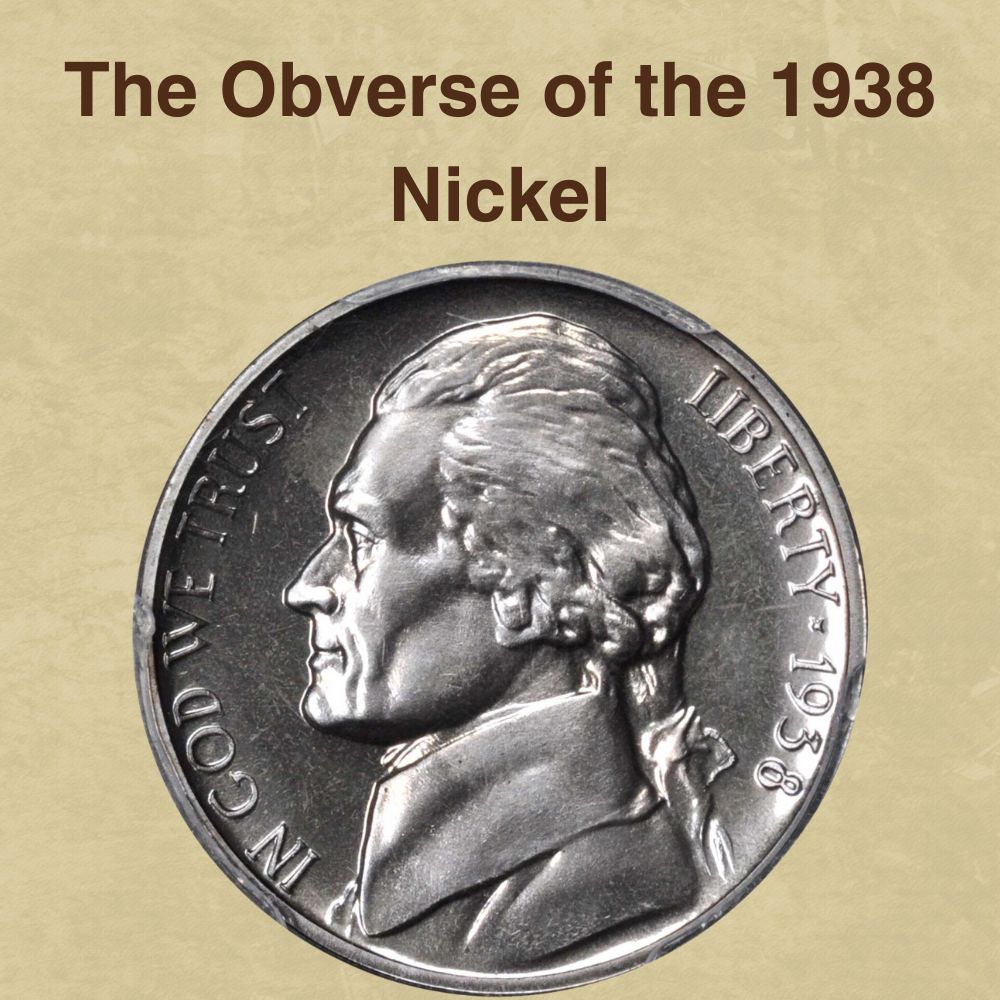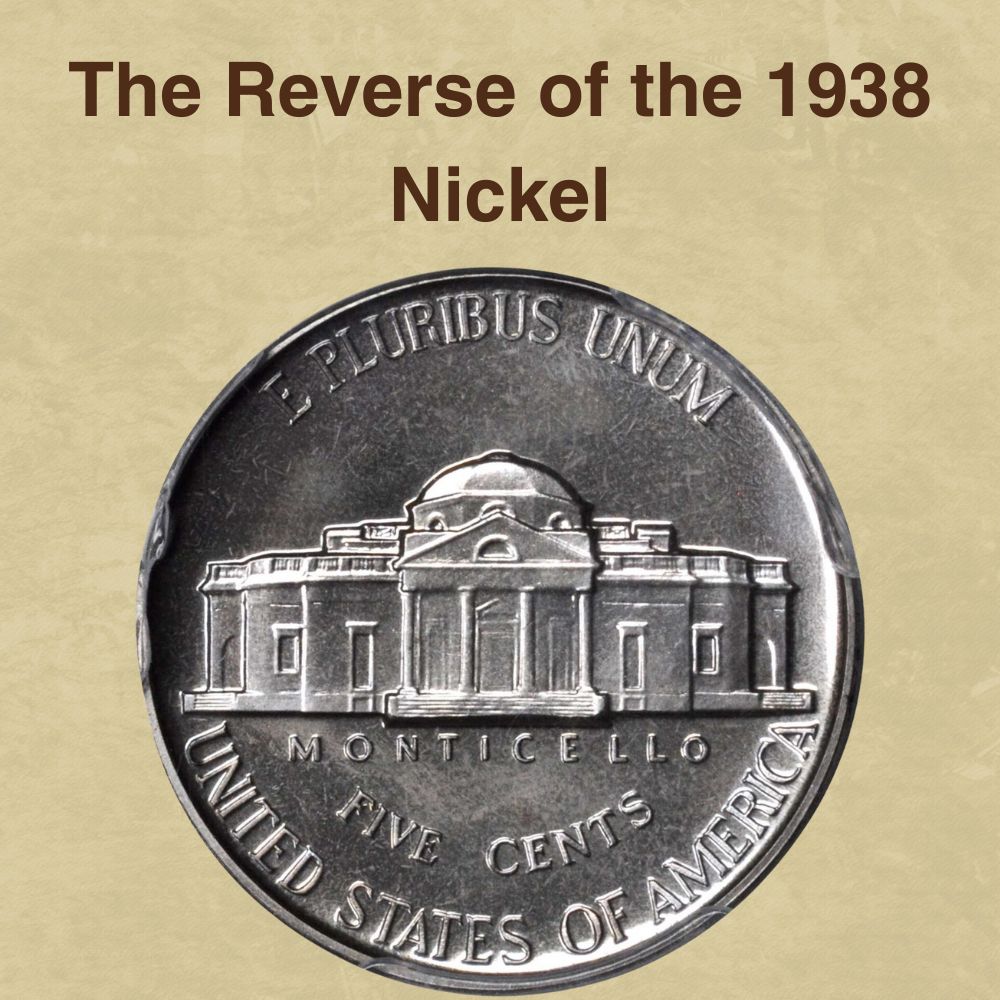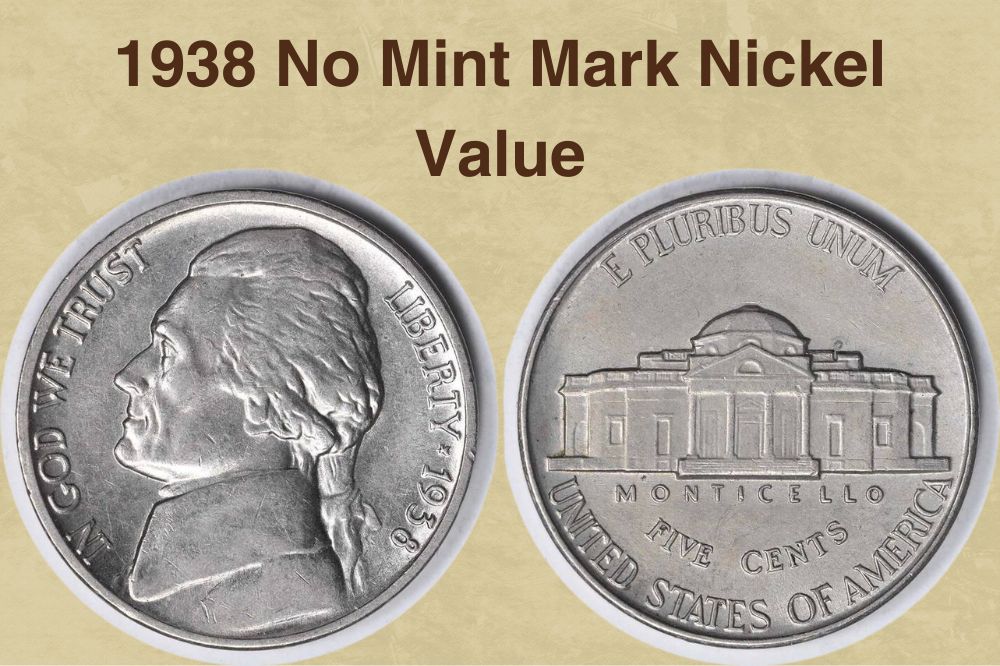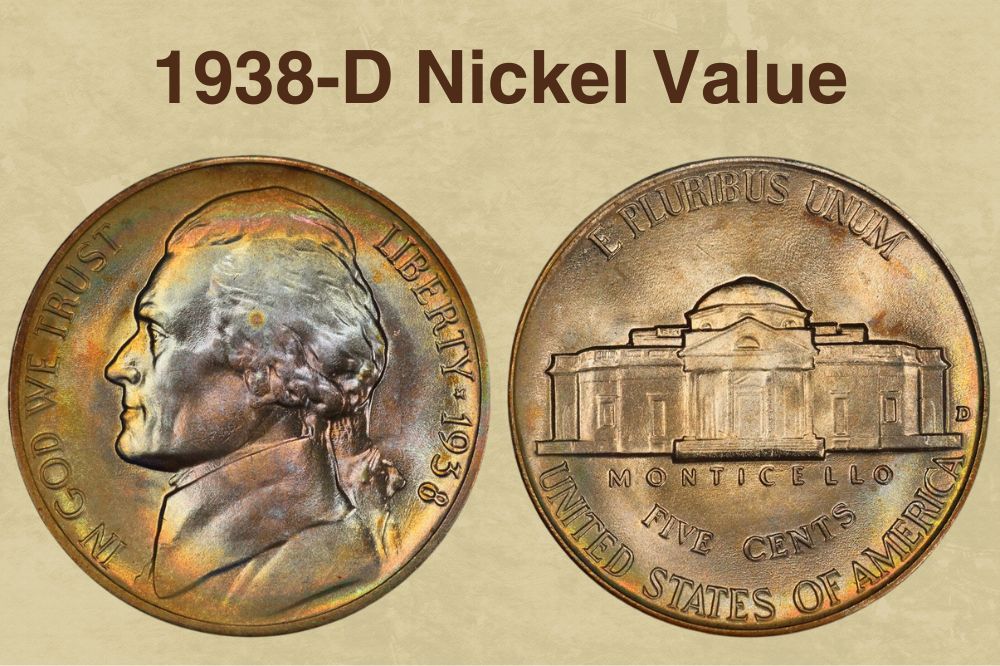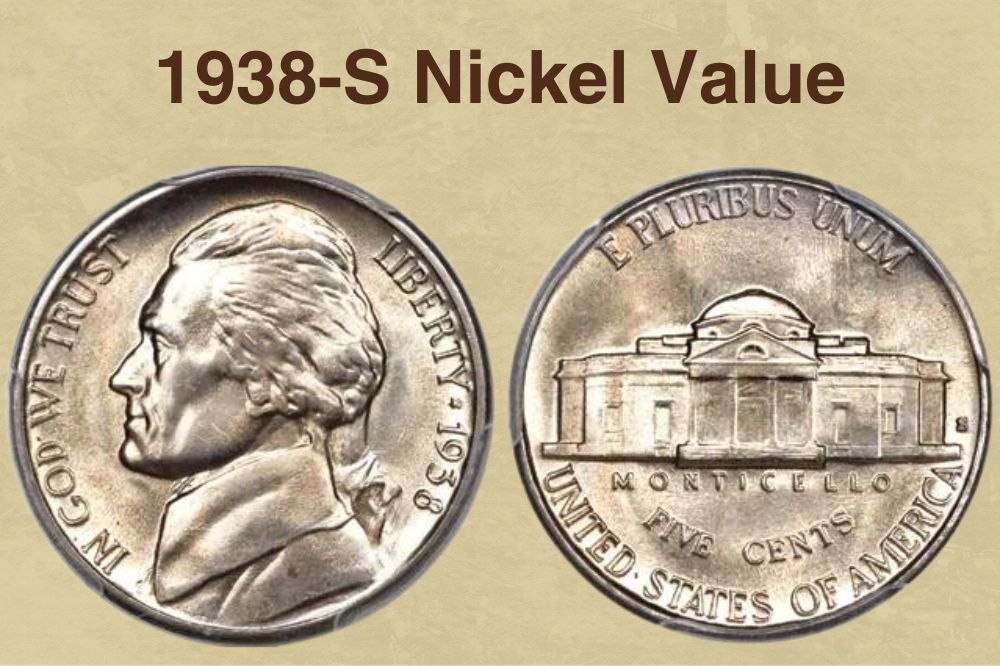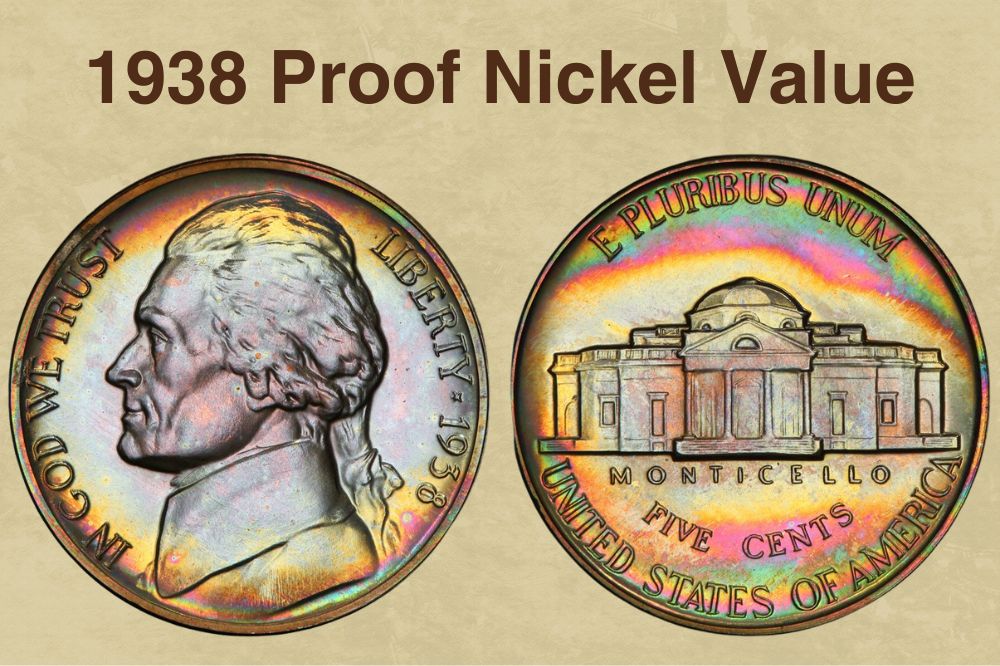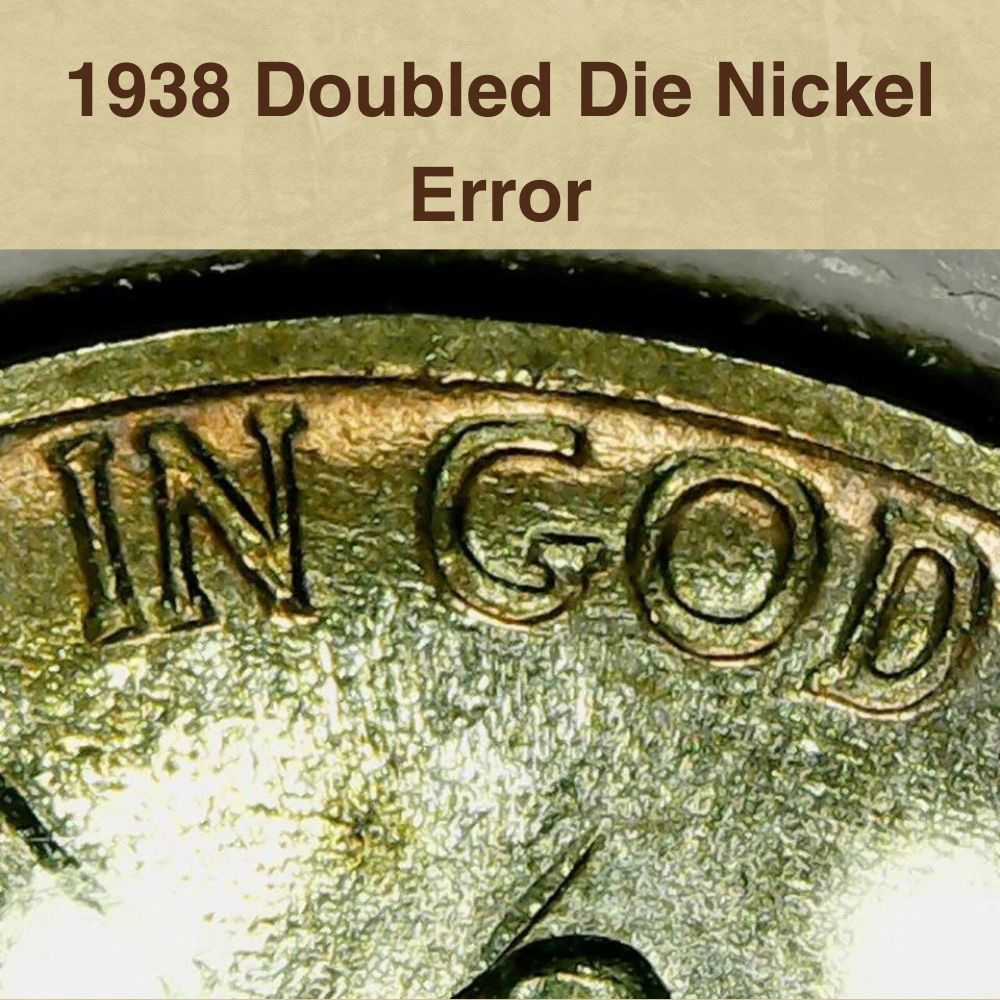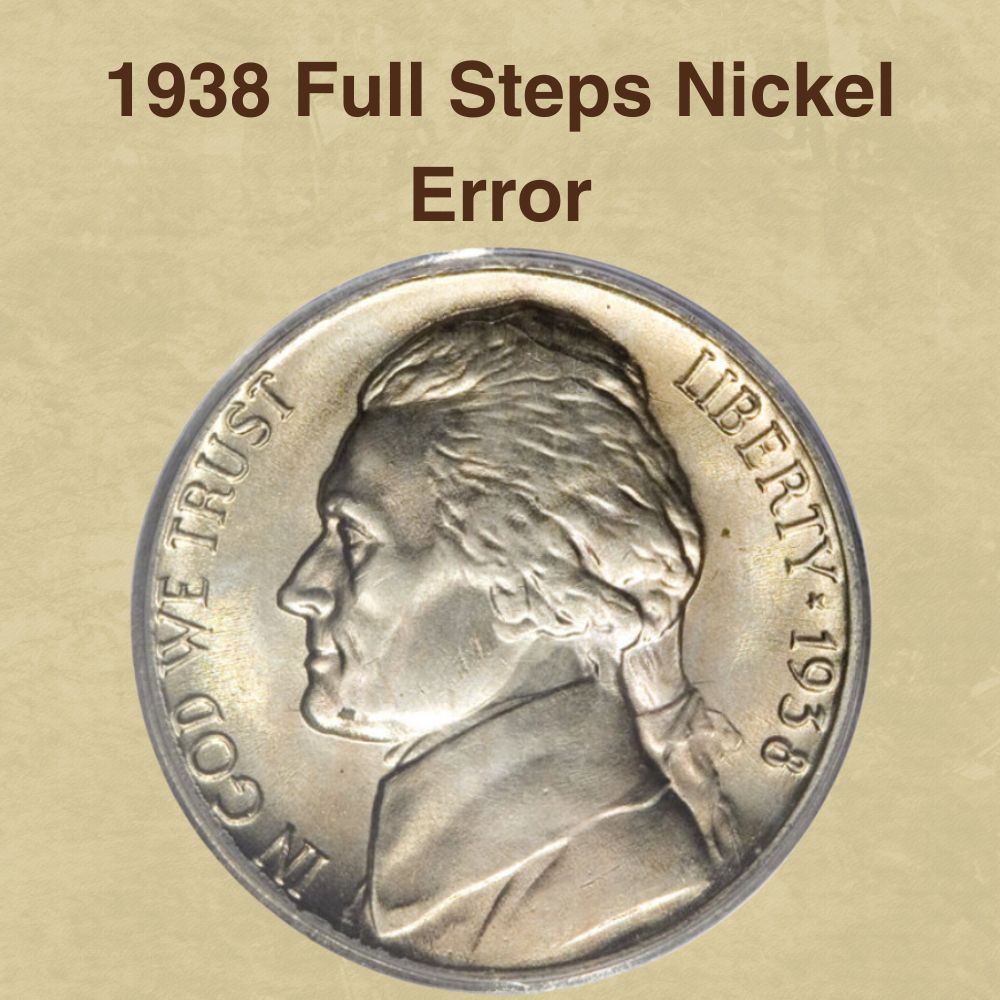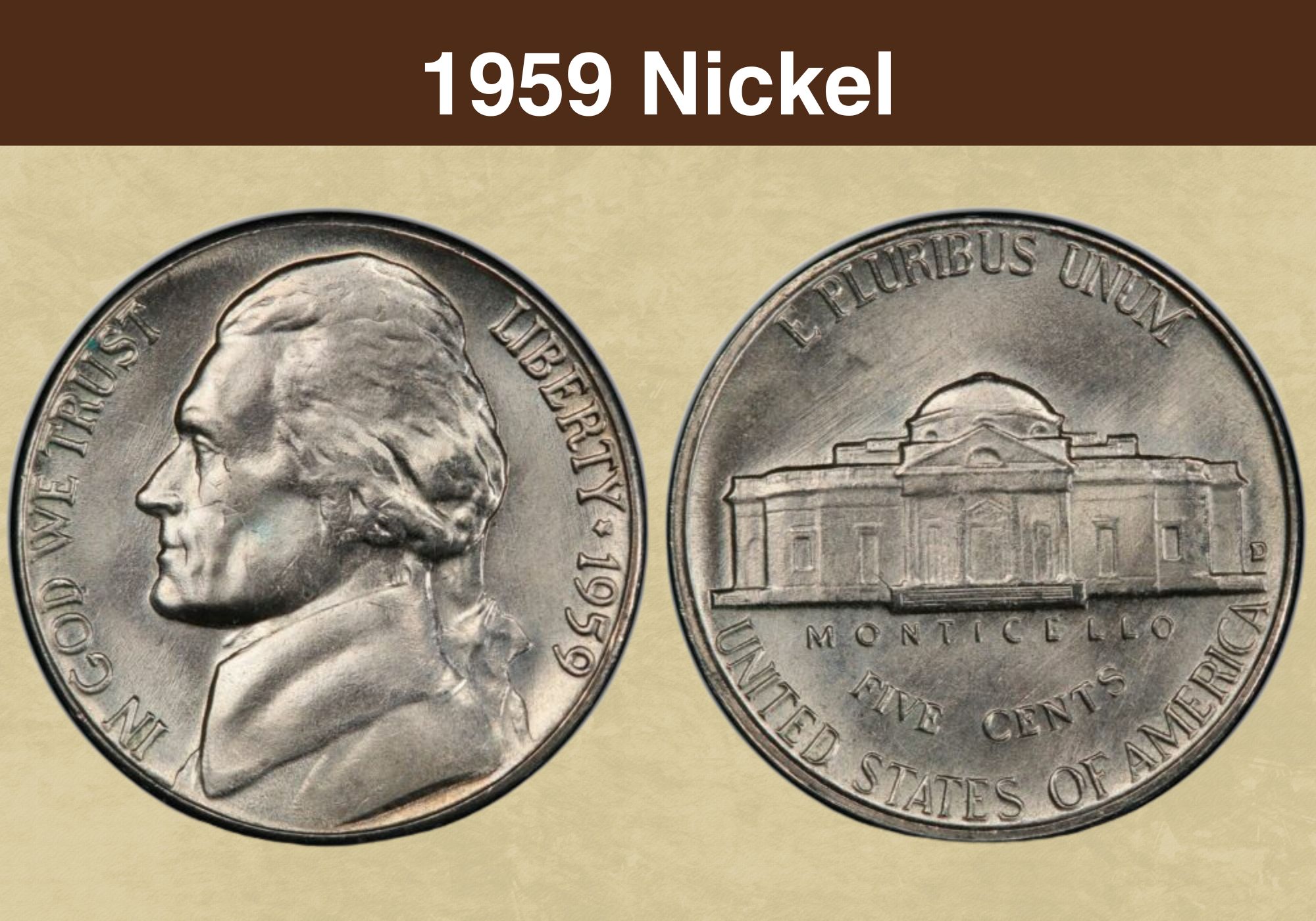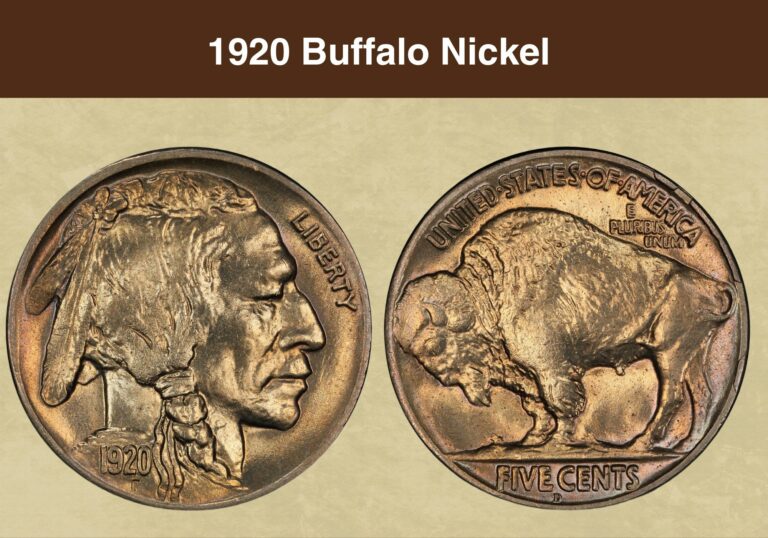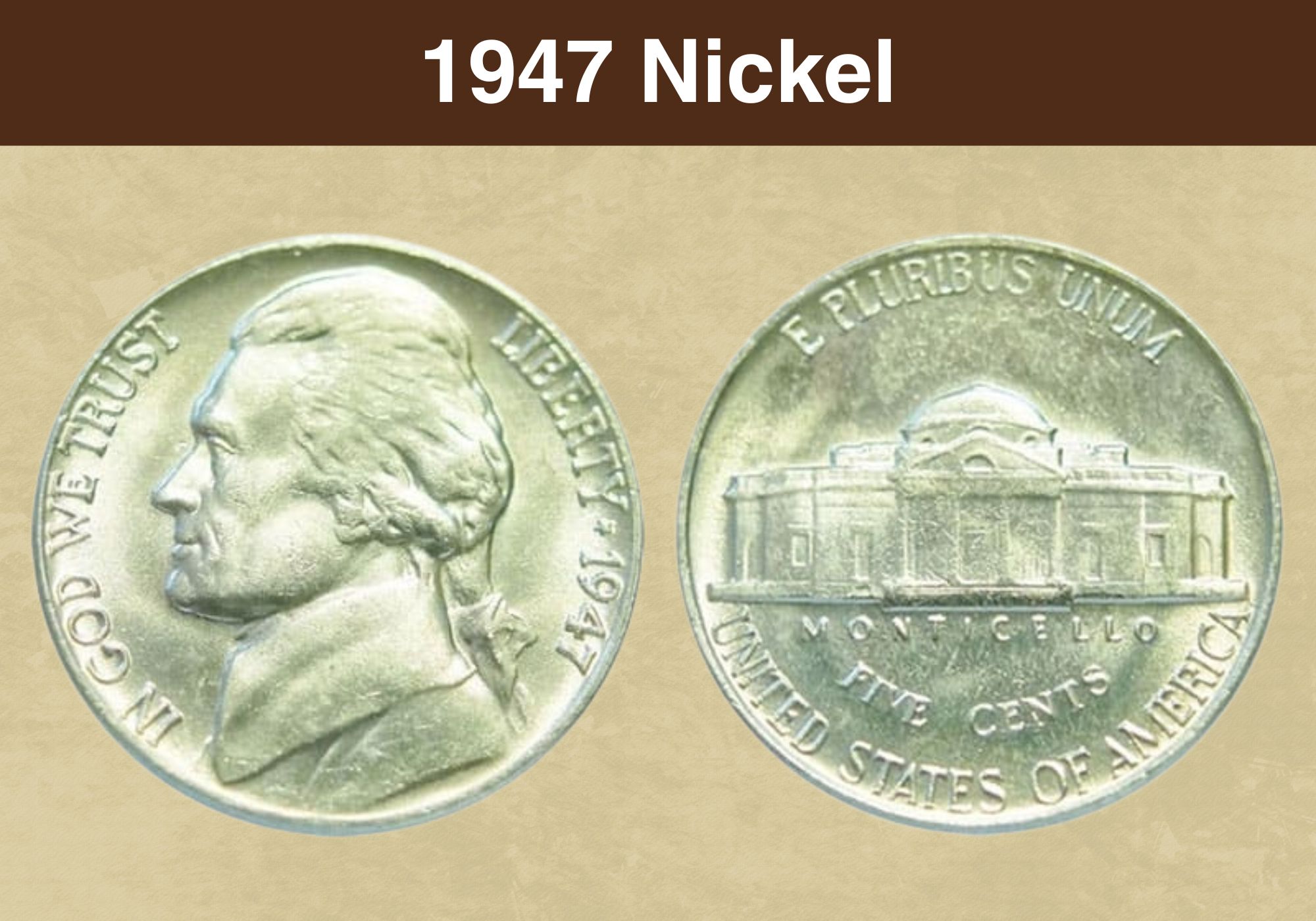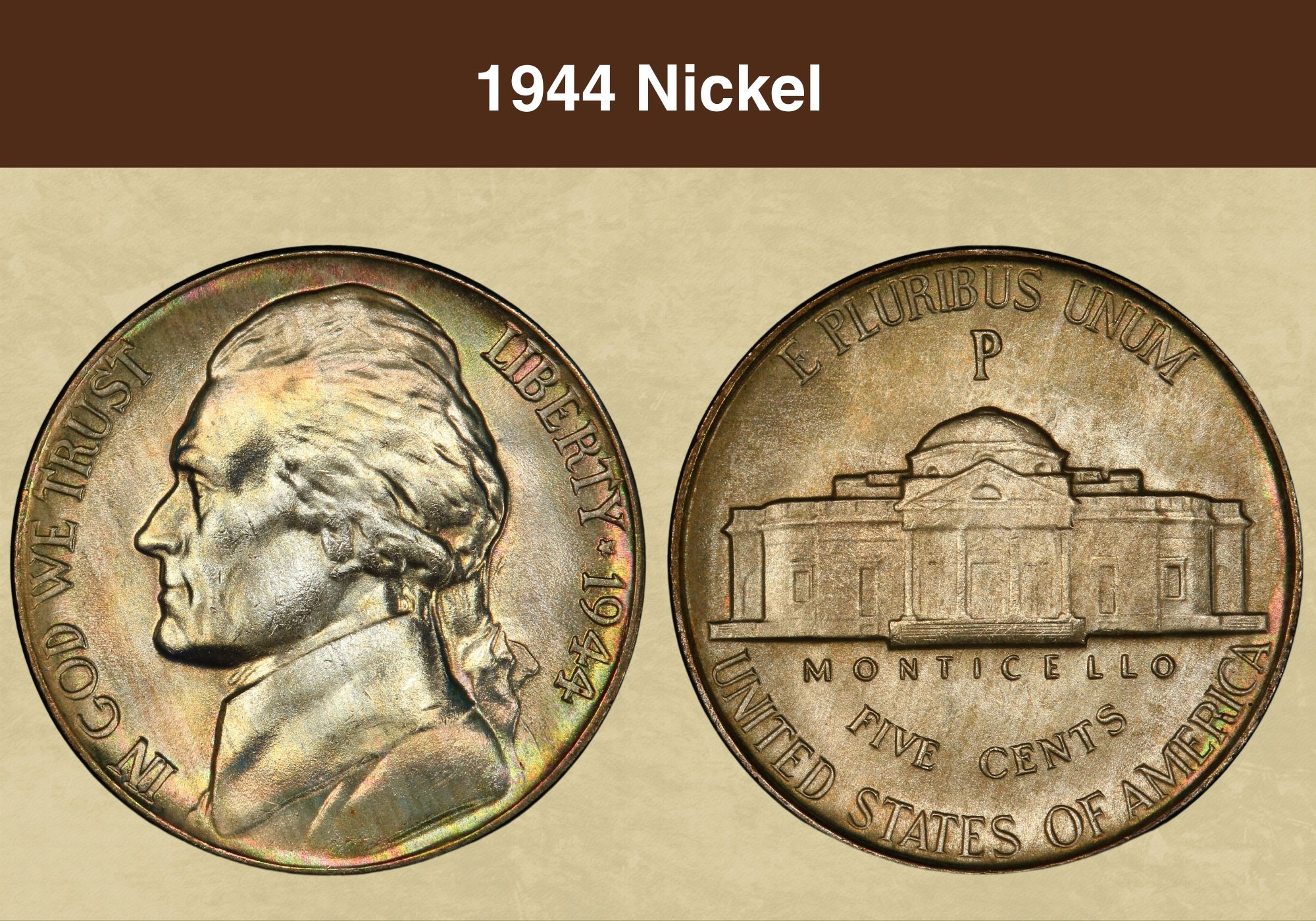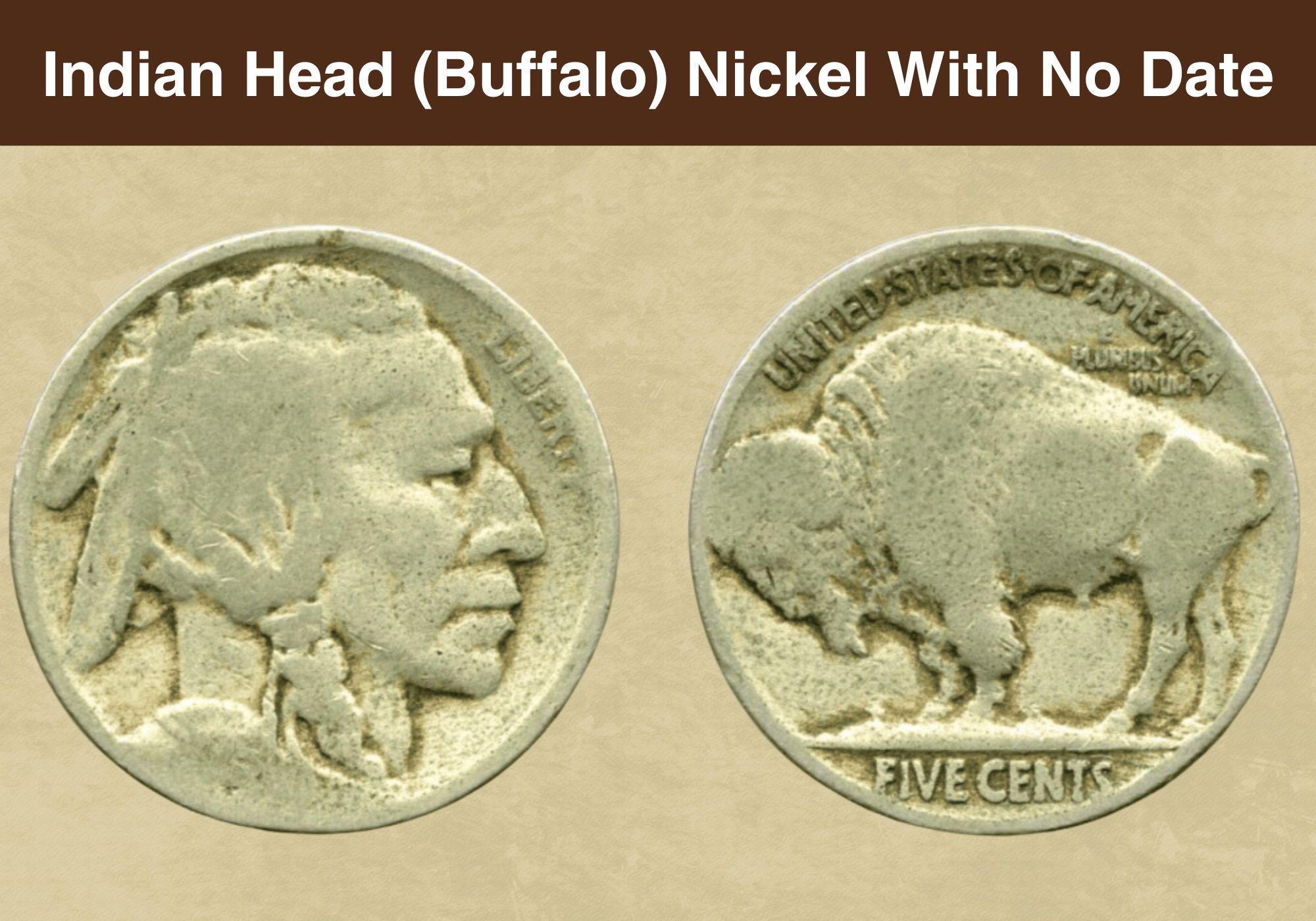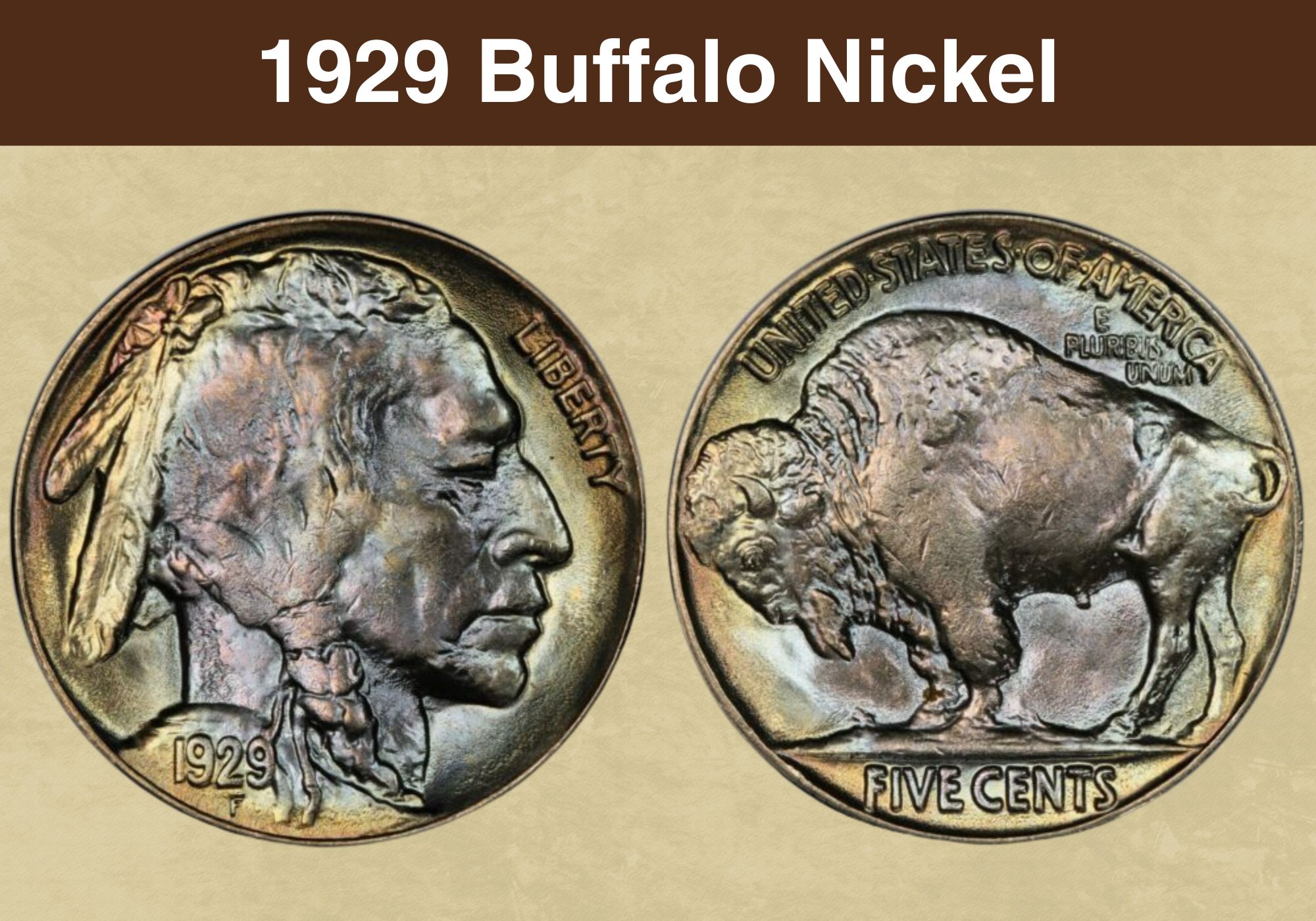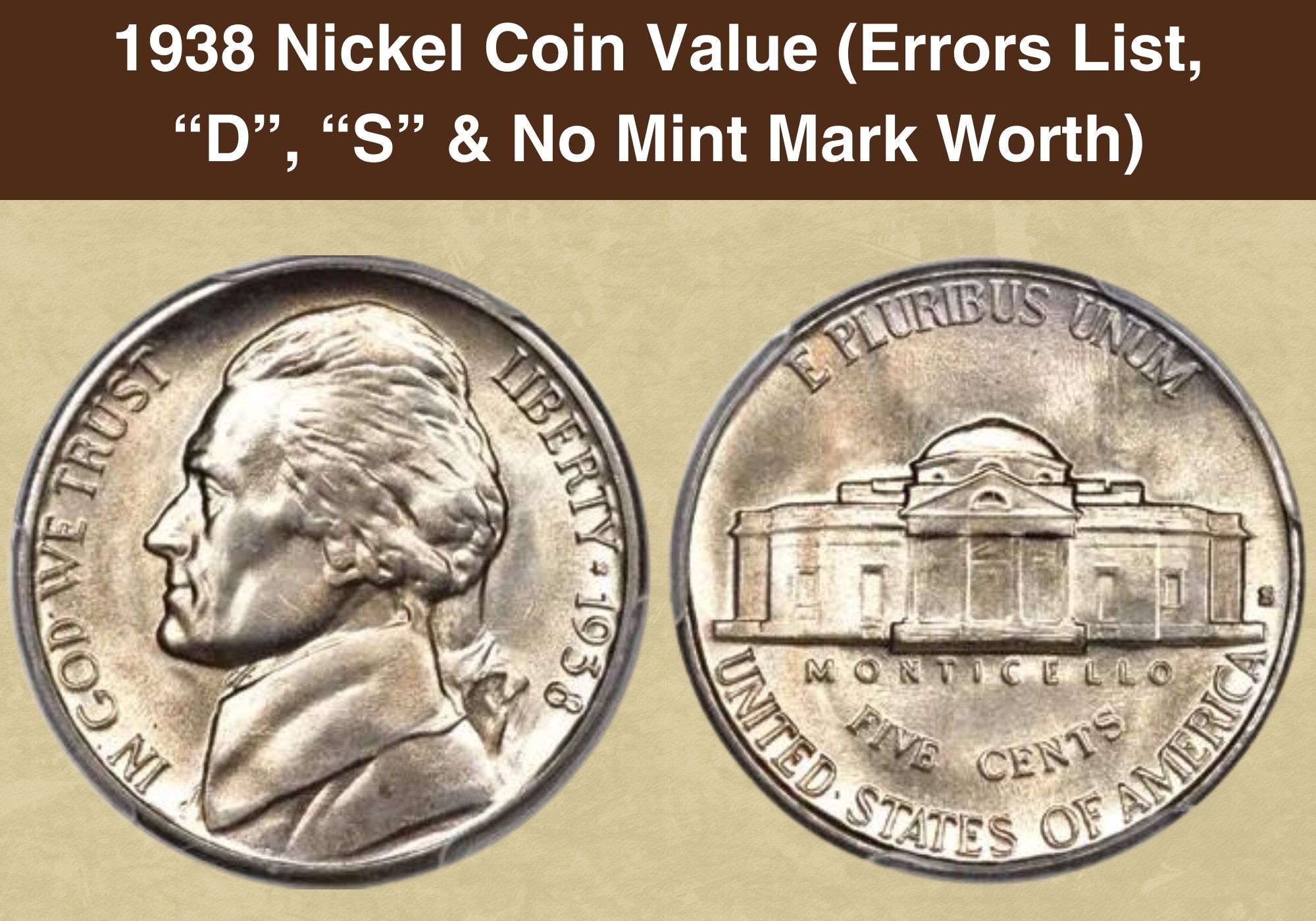
Coin Value Contents Table
Do you own a 1938 Jefferson nickel? Or have you come across this old coin?
The truth is, finding a 1938 nickel in your pocket change is highly unlikely. These are obviously very old coins; most are extremely worn, making them less valuable.
That said, 1938 is historically significant because it is the year when the United States Mint first issued the Jefferson nickel. Unsurprisingly, collectors have always been interested in the 1938 nickel value.
So, is the 1938 nickel worth collecting? This guide will answer this question in depth. We will discuss the coin’s history, unique features, and tips for grading the Jefferson nickel.
Without further ado, let’s get started and discover the value of the 1938 nickel.
1938 Nickel Value Chart |
||||
| Mint Mark | Good | Fine | Extremely Fine | Uncirculated |
| 1938 No Mint Mark Nickel Value | $0.25 | $0.40 | $1.25 | $600 |
| 1938-D Nickel Value | $0.90 | $1.15 | $1.80 | $2000 |
| 1938-S Nickel Value | $1.10 | $1.65 | $2.40 | $2000 |
| 1938 Proof Nickel Value | – | – | – | $2750 |
History of the 1938 Nickel
The nickel is the present-day 5-cent coin. The United States Mint issued the Jefferson nickel in 1938, replacing the hard-to-mint buffalo nickel.
The Mint launched a competition in which the winning sculptor or coin designer would be required to create a coin depicting Thomas Jefferson, a founding father and our country’s third president.
Artist Felix Schlag won the competition, and the Mint commissioned him to design the new nickel with Jefferson on the obverse and his Monticello home on the reverse.
After several iterations, the Mint approved Schlag’s design. The coin went into production in October 1938 and was released into circulation in November of the same year.
The public, anxiously awaiting the release of the Jefferson, immediately began hoarding the coin, resulting in a nickel coin scarcity that lasted well into the early 1940s.
From 1938 to 2003, the Jefferson nickel retained the same obverse and reverse design. From 2004 to 2005, the reverse bore a commemorative design before resuming the original Schlag design.
In the next section, we shall look at the physical attributes of the 1938 Jefferson nickel.
Features of the 1938 Nickel
Learning your coin’s features can help you identify the ones that are worth good money.
If you know what to look for in a Jefferson nickel, you can quickly spot one that is worth more than its face value.
Let’s explore the features of the 1938 nickel.
The Obverse of the 1938 Nickel
On the obverse of the 1938 nickel, Thomas Jefferson’s left-facing portrait takes center stage. His hair is held in a pigtail while he adorns a high-collar jacket.
The motto, IN GOD WE TRUST, appears clockwise along the coin’s left edge.
Meanwhile, the word LIBERTY and the year date appear clockwise along the right edge. A small five-star separates the two inscriptions.
The Reverse of the 1938 Nickel
On the coin’s back side, you will find a depiction of Monticello, a mansion Jefferson designed and lived in. The word Monticello translates to “little mountain” in ancient Italian vernacular.
The motto E PLURIBUS UNUM appears at the coin’s top edge. The name Monticello underlines the building itself. Including the building’s name is one of the changes the Mint required Schlag to implement before coin production began.
The coin’s denomination, FIVE CENTS, appears in a slight curve right after the word MONTICELLO. The words UNITED STATES OF AMERICA follow along the base.
Other Features of the 1938 Nickel
The 1938 nickel is made of 75 per cent Copper and 25 per cent Nickel.
The coin measures 21.20 millimeters in diameter and weighs 5 grams. It has a plain edge.
The Philadelphia, Denver, and San Francisco mints all struck the inaugural Jefferson nickel in 1938, but only the nickels produced in Denver and San Francisco bear the mint marks D and S, respectively.
The mint mark on the 1938 nickel appears on the reverse to the right side of the Monticello.
1938 Nickel Value Guides
So, what is the value of the 1938 nickel? How much your Jefferson nickel is worth will depend on factors such as the coin’s condition, mintage, rarity, and collector demand.
The 1938 nickels are generally accessible across all grades, but you will not find these coins easily in your pocket change. They are old, and most were hoarded, lost, destroyed, or melted for copper.
Most of the 1938 nickels you will come across are heavily circulated and worn out. These coins are usually more or less their face value and will hardly fetch a premium in their circulated form.
There are three varieties of the 1938 nickel, whose value we will look. These include the:
- 1938 No Mint Mark Nickel
- 1938-D Nickel
- 1938-S nickel
1938 No Mint Mark Nickel Value
The Philadelphia Mint produced the highest mintage of the 1938 nickel, an estimated 19 million coins. Nickels from this facility do not have a mint mark on either the obverse or reverse side.
The 1938 no-mint mark Jefferson nickels are plentiful across all grades, but they start attracting premium prices at graded MS65.
A circulated 1938 nickel is worth between $0.25 and $2.75. Uncirculated examples graded MS67 can fetch as much as $600, but such gem-quality specimens are extremely rare.
According to the Professional Coin Grading Service (PCGS), the most expensive 1938 no-mint mark nickel was graded MS67 and sold for a whopping $3,562 at a 2023 eBay auction.
1938-D Nickel Value
The Denver mint struck about 5.4 million nickels in 1938, a drastic decrease in mintage from the numbers recorded at the Philly facility.
Unsurprisingly, finding 1938 nickels with no mint mark on the reverse is much easier than finding ones with a D mint mark. Due to the low mintage, collectors consider 1938-D nickels to be a semi-key date.
High-grade and gem-quality specimens are plentiful. This is the only date before the 1965 era when nickels graded MS68 can be easily accessed, and five or six full steps examples can be found.
Circulated 1938-D nickels are worth between $0.90 and $3.30. Uncirculated examples begin to fetch a premium at grade MS67 onwards, where they are worth up to $250.
Gem-quality or superb examples of 1938-D nickels are extremely rare, often fetching as much as $2,000. PCGS records show that one such example was graded MS68 and was snatched up in 2004 for a whopping $5980.
1938-S Nickel Value
Last but not least are the nickels produced by the San Francisco facility. The Mint struck only 4 million of these coins, the lowest mintage in the 1938 Jefferson nickel series and a key date.
Like the Philly and Denver nickels, the 1938 nickels struck in San Francisco have a weak obverse and reverse design, as they were struck from low-quality die hubs. This weakness in design diminishes a coin’s value, as is the case with 1938 nickels.
Still, gem-quality examples of the 1938-S nickel are still readily available as most were hoarded and never released into circulation.
Circulated 1938-S nickels will fetch between $1.10 and $3.90, depending on the grade. In uncirculated condition, prices for a 1938-S nickel start at $4.75 and can peak to $400 at grade MS67 and as much as $2000 for the rare specimen graded MS68.
1938 Proof Nickel Value
In addition to the regular nickels, the Mint at San Francisco produced proof coins for collectors. Only 19,300 proof nickels were struck that year, one of the lowest mintages in the Jefferson nickels series.
Most available examples are graded MS64 to MS66. Specimens graded MS67 are equally available but rare, and anything above MS68 is extremely scarce and would be worth a fortune.
The most expensive 1938 proof nickel is graded PF67 and was sold for an impressive $5980 at a 2001 Heritage Auctions.
1938 Nickel Grading
The Sheldon 70-point scale will come in handy when you want to grade your coins.
Grading the 1938 nickel is not an exact science, but following the Sheldon grade can help you determine whether your coin is valuable.
Pay attention to the coin’s condition, luster, presence of contact marks, strike, and possible minting errors.
The Full Steps variation is an important factor to consider when grading Jefferson nickels. This variation refers to the visibility of the Monticello staircase or outdoor steps.
The more visible and clear-cut the steps are, the more valuable a coin is considered. A Jefferson nickel with five or six full steps is considered mint state and highly desirable.
An uncirculated Jefferson nickel will have a noticeably shiny luster, few if any contact marks, and a sharp strike on the obverse and reverse.
Circulated examples will have a visible loss of luster, several contact marks and flaws, and a dull strike. The extent of each of these factors will then determine the coin’s grade based on the Sheldon scale.
Check out this for more tips on grading your Jefferson nickels.
1938 Nickel Errors
Only about 29 million nickels were produced in 1938, and with such a low mintage, you’d expect few minting errors. There aren’t many 1938 nickel errors, but the well-known ones can be worth more than face value.
Here are some 1938 nickel errors worth money.
1938 Doubled Die Nickel Error
The doubled die is the most common error seen on 1938 nickels. This error occurs when the die strikes the planchet at different angles, causing an overlap in the inscriptions and/or the images.
Doubling is often visible on Jefferson’s forehead, hair and collar, in the motto IN GOD WE TRUST. On the reverse, you might notice a doubling on the Monticello and denomination inscriptions.
Depending on the extent of the doubling error, collectors pay as much as $15 for 1938 nickels with a doubled die error.
1938 Re-punched Mint Mark Nickel Error
A re-punched mint mark error occurs when the mint mark is struck at different angles or positions.
These errors are also very common among the early Jefferson nickels, given that mint works punched mint marks manually and were, therefore, bound to position the mint mark incorrectly with each punch.
If you come across a 1938 Jefferson nickel with a re-punched mint mark, you can expect up to $100, depending on the coin’s condition. This error is highly sought-after and, therefore, worth good money.
1938 Re-punched Date Nickel Error
In addition to the repunched mint mark error, the re-punched date error is another error that appears among 1938 nickels.
This error occurs in the same way as a repunched mint mark. Incorrect positioning of the die can cause the date to be struck at different angles, resulting in doubling or overlapping.
Repunched date errors can fetch as much as $20.
1938 Full Steps Nickel Error
The Full Steps designation is not an error but a sought-after variety.
Full Steps refer to the complete steps on the Monticello, a feature that can increase a nickel’s value by as much as 20 times its normal value.
Jefferson’s nickels from 1938 with all six full steps are extremely rare, given that weak dies were used to strike these coins. The mint sharpened the dies only in 1939, rendering the Monticello steps more visible.
In 2022, Heritage Auctions sold a 1938-D Full Steps Nickel graded MS68+ for an eye-watering $33,600.
FAQS
Is a 1938 nickel made of silver?
No. Despite its silver appearance, the 1938 nickel does not contain silver. This coin is made of 75% copper and 25% nickel, with the Nickel contributing to the coin’s shiny appearance.
Is a 1938 nickel rare?
A 1938 Jefferson nickel is not one of those coins you will easily find in your pocket change. While it is not a very old coin, it is noteworthy for its low mintage, which makes it scarce, especially in uncirculated condition. Long story short, 1938 nickels are not rare but scarce, and finding brilliant uncirculated specimens may require a lot of time and effort.
How much will I get from selling a 1938 Jefferson nickel?
The amount you can expect will depend on several factors, most importantly the coin’s grade.

